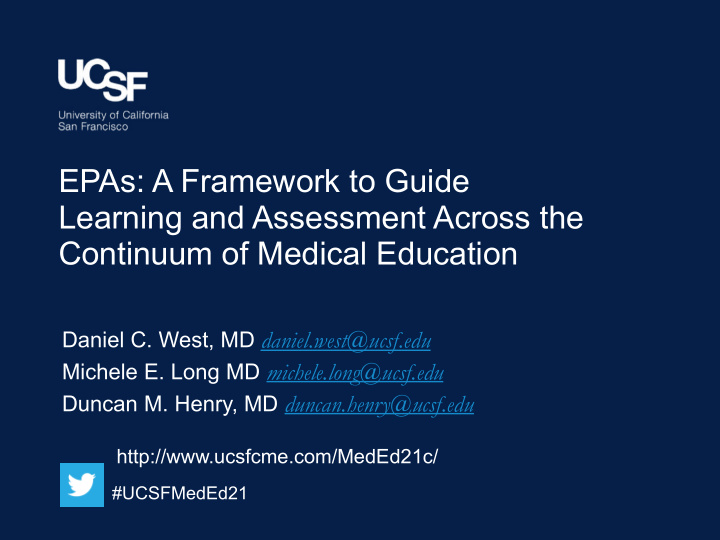



EPAs: A Framework to Guide Learning and Assessment Across the Continuum of Medical Education Daniel C. West, MD daniel.west@ucsf.edu Michele E. Long MD michele.long@ucsf.edu Duncan M. Henry, MD duncan.henry@ucsf.edu http://www.ucsfcme.com/MedEd21c/ #UCSFMedEd21
Objectives § Understand key features of EPAs and strategies for assessment § Identify advantages and disadvantages of two different competency assessment forms (tools) § Interpret EPA-based assessment data and use it create a learning plan and make a competency decision § Consider how you might implement an EPA- based assessment framework in your setting
Workshop Plan § Brief introductions (West) § Definitions, Terms, Framework (Henry) § Competency-Based Assessment (Long) • Compare and Contrast Forms § Practice interpreting real assessment data (West) • Develop learning plans • Make competency (entrustment) decisions § Implementation and barriers (Henry) § Take home points and questions
Competency-Based Medical Education: Definitions, Terms, Framework
Competency Frameworks ACGME (US) Patient care Medical knowledge Practice based learning and improvement Interpersonal and communication skills Professionalism Systems-based practice The Scottish Doctor 12 outcome domains by Tomorrow � s Doctors (UK) § What doctor able to do § How doctor approaches The Doctor as: practice 1) Scholar and Scientist § Doctor as professional 2) Practitioner 3) Professional
Entrustable Professional Activities (EPAs) § Concrete clinical activities that a physician (e.g. pediatrician) performs • Defines what it is to be a resident (or pediatrician) § Requires synthesis of ACGME or LCME Milestone Competencies § Competency standard based on level of supervision required • Goal is to do activity unsupervised § Individualized to trainee and criterion-based (rather than normative-based)
EPA: Examples For Undergraduate Medical Education • Gather a history and perform a physical examination (EPA #1) For Graduate Medical Education • Manage patients with acute, common diagnoses in emergency, ambulatory, and inpatient settings (Pediatrics EPA #4 ) 7 2/27/18
Competencies and EPAs Competencies (eg. Milestones) EPA 1 2 3 4 5 6 A XX X XXX Observable B XX XX X C X XXX D X X XXX E XX XX Inferred Ten Cate & Scheele, Acad Med 2007
When is Competency Achieved? EPA Competency on a Continuum EPA2 EPA4 EPA3 EPA1 Competence EPA5 Threshold Evidenced-based entrustment decisions training deliberate professional practice Modified from Ten Cate
EPA Assessment Building Activity § Choose either an AAMC Core EPA … • Gather a history and physical examination … § Or an American Board of Pediatrics EPA … • Manage acute common problems in a variety of settings § Using the handout and worksheet, begin to build an assessment based on observable key activities of the EPA (5 min) 10
Assessment of Competency: Compare and Contrast Assessment Forms
Example Competency Based Form
Competency-Based Form: Close Up
Example EPA Form
EPA Form: Specific Behaviors
EPA Form: Supervision Scale
EPA Form: EPA-Framed Feedback
Pair Share To Consider § Benefits/strengths of each form § Problems with each form § How each form could support/hinder coaching or working in a coaching system § Trainee reaction to the information on the form
Interpreting EPA-Based Assessment Data: Time to Practice
Small Group Exercise: Individually § Review aggregate EPA-based assessment data § Assign entrustment level § Develop on learning plan with one goal/objective In Pairs or Triplets § Assign consensus entrustment level
Example EPA Form
Interpreting EPA-Based Assessment Data: Large Group Discussion § What were your reactions to this exercise? § What did you think of this learner? § Any advantages or disadvantages to this approach to assessment?
Education in Pediatrics Across the Continuum (EPAC) § AAMC supported consortium of 4 schools • U Minnesota, U Colorado, U Utah, UCSF § Test competency-based, time variable model of advancement from UME-GME-practice § Pediatrics used a model § EPA-based Competency Framework
Entrustment/Supervision Scale Modified from: Chen HC, et al. Acad Med 2015; 90: 431-436
EPAC Example: Change in EPAs Over Time Time-Based Graduation Threshold Competency-Based Graduation Threshold Procedures Source: Alan Schwartz, PhD
When is Competency Achieved? EPA Competency on a Continuum EPA2 EPA4 EPA3 EPA1 Competence EPA5 Threshold Evidenced-based entrustment decisions training deliberate professional practice Modified from Ten Cate
UCSF Pediatric GME Assessment: Based on ABP EPAs
EPA Assessment Strategy at UCSF A Vision of Assessment for Learning Learning Activities Aggregate Data (e.g. patient care, IDP-goals) Clinical Entrustment: Advisor Assisted Workplace Competency Independent Reflection Assessment Committee Practice Assessment-Based Additional Feedback (including Feedback ACGME Milestone Report)
EPA-Based Assessment: Implementation Issues Large Group Discussion § How would you structure use of EPA-based assessment in your setting? § What challenges and barriers to implementation might you expect? § How would you approach implementation?
Summary and Take Home Points § EPAs – just another competency framework • Make sense to learners and teachers • Provides intuitive criterion competency standard § Assessment data can support learning (feedback) and competency decisions § Implementation is challenging but achievable
UCSF is driven by the idea that great breakthroughs are achieved when the best research, the best education and the best patient care converge.
Back-Up Slides
EPA Form: Specific Behaviors
EPA Form: Supervision Scale
EPA Form: EPA-Framed Feedback
EPA Form: EPA-Framed Feedback
American Board of Pediatrics: EPAs for General Pediatrics
Recommend
More recommend